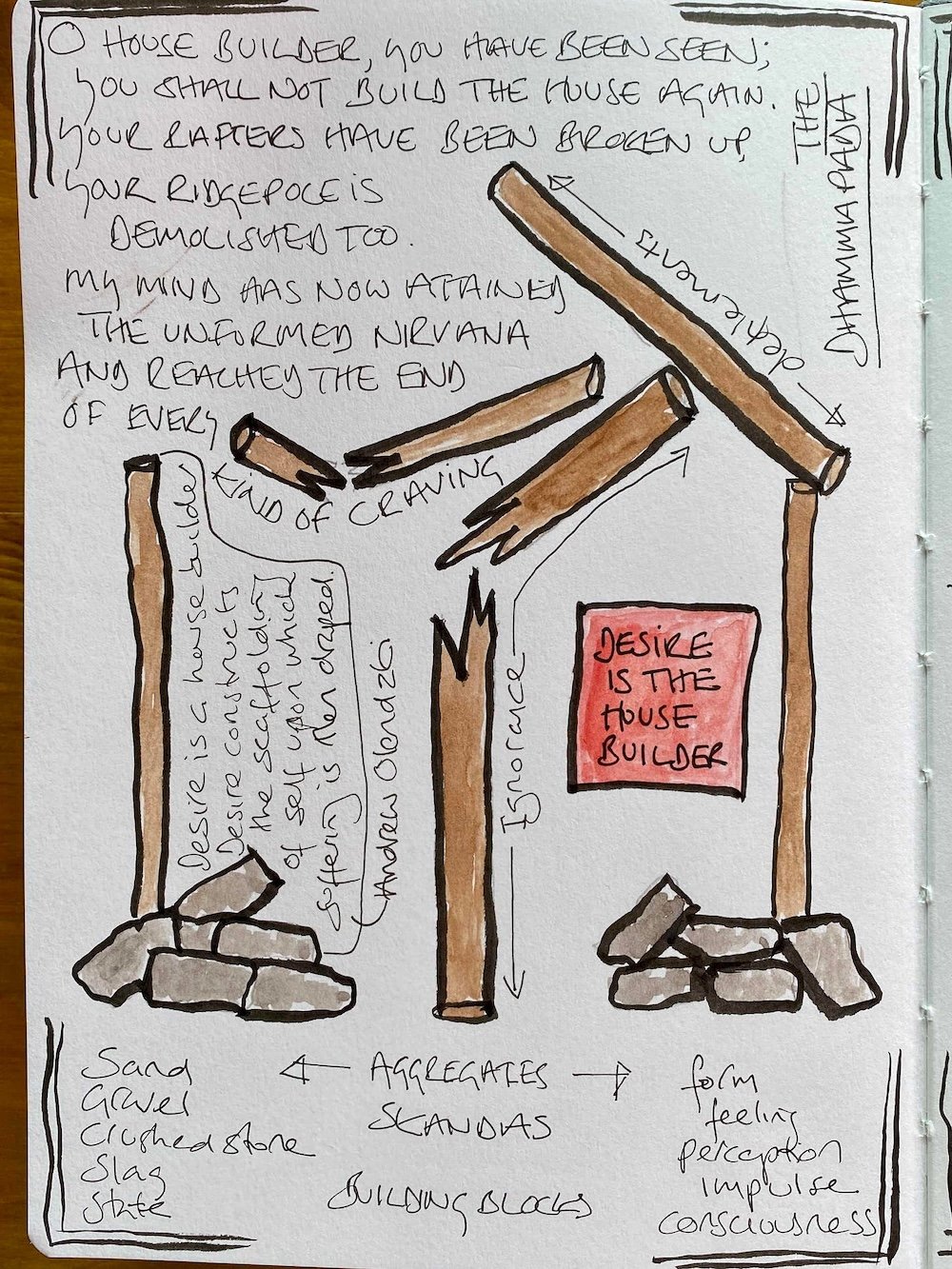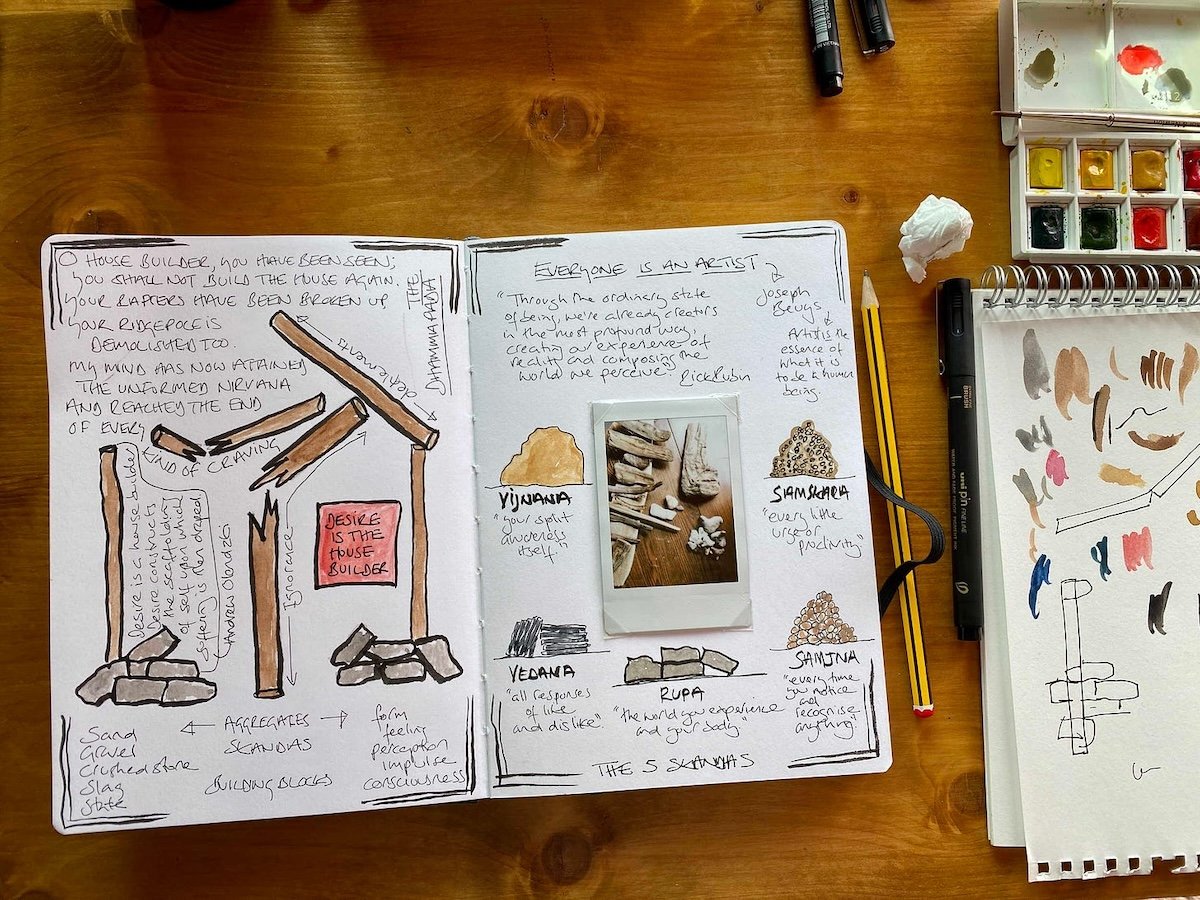Everyone is an artist
An introduction to the 5 skandhas and how we build our self and world from their raw materials.
It was Joseph Beuys who said, ‘Everyone is an artist’.
“It’s probably his most famous quote but also the most misunderstood. Because what Beuys did not mean is that everyone is an artist in the usual and narrow sense of the word, like a painter or a sculptor.
For Beuys “artist” was the word to describe the essence of what it means to be a human being: The deep need and fundamental ability to create and be creative.”
The metaphor of the artist was key for my own teacher, Sangharakshita. He made strong connections between the Dharma and art in his own teachings writing a book early on called The Religion of Art. For him, the path was a path of creativity.
The Buddha preferred the metaphor of ‘builder’. How many people had time for art in those days? But everyone had to build and rebuild their houses, often with their own hands.
The metaphor of builder/demolisher…
One of the Buddha’s most famous verses about awakening uses the ‘house builder’ at its core:
O house builder, you have been seen;
you shall not build the house again.
Your rafters have been broken up,
your ridgepole is demolished too.
The mind has now attained the unformed Nirvana
and reached the end of every kind of craving.The Dhammapada
The verse uses another metaphor, one of demolition. I find it strangely thrilling, but then destruction is.If you’ve not had the opportunity to knock down a wall, you at least know that feeling of dropping glass bottles into the bottle back and hearing them smash. It feels naughty.
(I got to know a good friend while ripping out a shower together in a retreat centre. We shouted to the plumber to come and disconnect the pipe. He insisted it was disconnected, we insisted it wasn’t. Finally, it dawned that we’d ripped out the wrong shower!)
Who is this house builder? Who has been seen?
“Desire is the house builder. Desire constructs the scaffolding of self upon which suffering is then draped.”
Andrew Olendzki
It might be thrilling in one way, but having my house demolished isn’t a wholly inspiring image to me. Unless the house is a kind of prison? Like Rumi’s “Why do you stay in prison, When the door is so wide open?”. After all, the Buddha left his own home to become a wanderer.
I like to balance the metaphor of builder/demolisher with that of artist/creator.
The metaphor of the artist/creator
The artist is like the house builder. The artist takes their ‘aggregates’, the materials they use, and makes something of them. A movie, a sculpture, an image.
We are all creating our worlds, from moment to moment, out of the raw materials of experience.
“To create is to bring something into existence that wasn’t there before. It could be a conversation, the solution to a problem, a note to friend, the rearrangement of furniture in a room, a new route home to avoid a traffic jam.
What you make doesn’t have to be witnessed, recorded, sold, or encased in glass for it to be a work of art. Through the ordinary state of being, we’re already creators in the most profound way, creating our experience of reality and composing the world we perceive.
In each moment, we are immersed in a field of undifferentiated matter from which our senses gather bits of information. The outside universe we perceive doesn’t exist as such. Through a series of electrical and chemical reactions, we generate a reality internally. We create forests and oceans, warmth and cold. We read words, hear voices, and form interpretations. Then, in an instant, we produce a response. All of this in a world of our own creation.”
— Rick Rubin: The Creative Act
The nirvana of the Dhammapada above is all about cessation, the house builder stops and the house falls into ruin. (I’ve written more about this ‘cessation’ view of nirvana here).
The image of the artist on the other hand offers us a creative path, what Sangharakshita calls the spiral path. A path of recreating ourselves and our world in ways that are freer, happier, more curious, fresher… (what experience do you want to create?).
Is it possible to hold both these ideas of the path together, both the stopping and the never ending creativity? If you can you’ll find yourself closer to the truth of the matter!
What are the raw materials?
The skandhas are the raw materials and the teaching of the 5 skandhas is essential dharma.
If you look up a translation of ‘skandhas’, one word you’ll find is ‘aggregates’ and if you do a Google search for aggregates, builder’s merchants will pop up advertising sand, gravel, crushed stone, slag and slate.
(The Buddha was really keen on his building metaphors. Apparently, the word karma can mean to build.)
These 5 skandhas are the building blocks of all experience:
Rupa/Form:The world you experience and your body.
The world and our body are experienced as sensations. It’s made up of the 5 physical senses, sights, sounds, smells, tastes and textures, as well as the mind sense which throws up thoughts and images.
Vedana/Feeling:All responses of like and dislike.
In the face of this changing mass of sensations, they’ll be a response of liking, or not liking, or just a neutral feeling.
Samjna/Perception:Every time you notice and recognise anything.
For the sensations to become ‘objects’ there has to be this act of noticing and recognising, we ‘pick things out’. We notice a tree; dog; foghorn; caramel and so on.
Samskara/Impulses:Every little urge or proclivity.
What we notice and like or dislike, is both conditioned by the past and will go on to condition the future.
Vijnana/Consciousness:Your split awareness itself.
All of this plays out in an awareness that continually divides experience into self and world, inner and outer.
Each of the skandhas is its own playground. A box of materials from which we create our own world. What kind of world do you want to create?
On Joseph Beuys by Varian Viciss
The Buddha’s Smile by Andrew Olendzki
The Spiral Path or Lokuttara Paṭicca-samuppāda by Jayarava Attwood
These translations of the skandhas come from Ratnaprabha’s free Translation of the Heart Sutra




